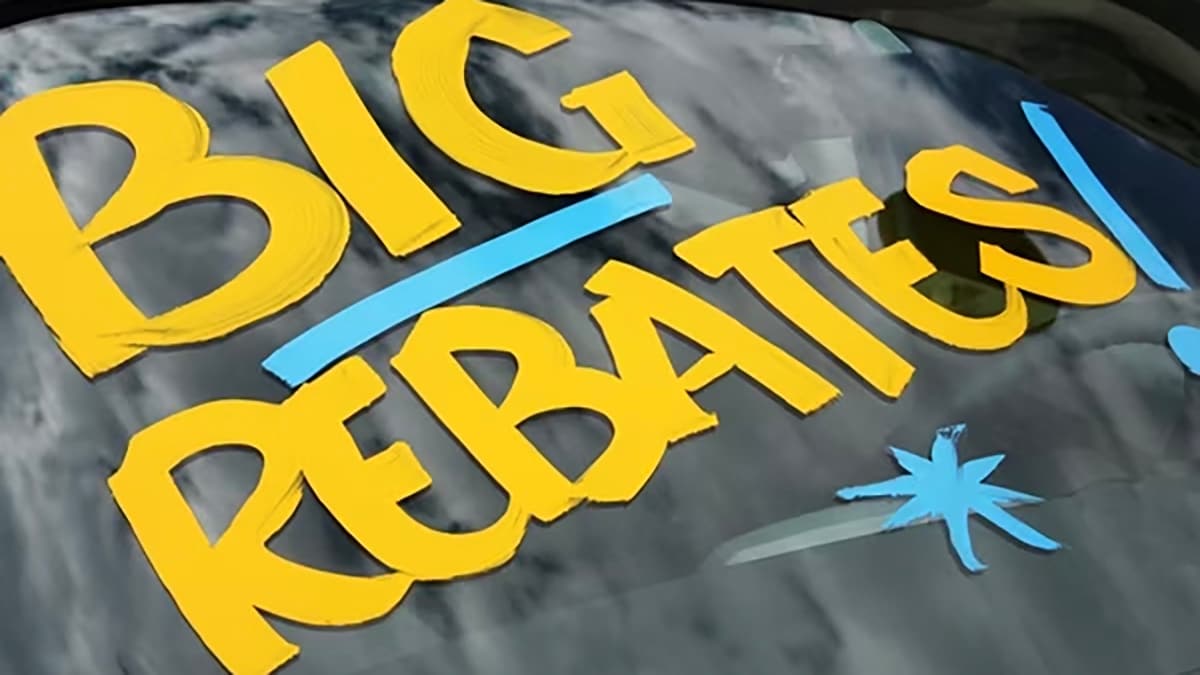- Car manufacturers and dealers offer incentives like cash rebates, low-interest financing, and lease deals to attract buyers and boost sales.
- Beyond cash discounts, non-cash perks like free upgrades, extended warranties, and service benefits can add extra value to your purchase.
- To maximize savings, research and compare incentives, negotiate the best deal, and ensure the car fits your long-term budget and not just the short-term discount.
You’ve probably seen the ads before: “$3,000 bonus cash on this model” or “0% financing on that model.” Perhaps these ads prompted you to visit your local dealership to check out the deals. If so, you’re not alone. These attractive discounts are known in the auto industry as “incentives.” It’s a way to drive down the cost to buy or lease a new vehicle to entice you to act.
According to Cox Automotive, Kelley Blue Book’s parent company, new-vehicle sales incentives at the end of 2024 equaled 8% of the average transaction price or approximately $3,958, which is a significant discount for consumers. Automakers typically place incentives on older models or slow sellers. Included on the list are cash-back offers, special interest rates, discounts, and lease deals. The benefit is that these incentives can mean big savings. Beyond these conventional offers, there are also other non-cash inducements that can work in your favor.
Recent and potential trade policies and tariffs could influence pricing and incentive availability. Verify advertised offers, as they can change frequently based on market conditions.
Here’s our guide on what to look for and how to negotiate the best deal.
- Customer Cash Rebate
- Low-Interest Financing
- Lease Deals
- Dealer Cash and Rewards
- Government Incentives
- Research Deals
- Compare Offers
- Shop Strategically
- Negotiate Car Deals
- Considerations Beyond Incentives
Types of New Car Incentives
Customer Cash Rebate
The simplest form of incentive is the cash rebate, a dollar amount that is applied to the price of a vehicle — lowering its purchase, finance, or leasing costs. These rebates — sometimes referred to as “cash back” or “bonus cash” — are offered regionally or nationally. These include offers to repeat buyers of a brand (“loyalty cash”) or buyers who have left a competing brand (“conquest cash”). Rebates also may extend to first-time car buyers, military members, first responders, and recent graduates.
Rebates sometimes target customers in specific regions, so verify eligibility requirements when shopping out-of-state.
Low-Interest Financing
Generally, the better your credit, the lower your auto loan interest rate will be. For those with excellent credit, automakers offer low or even 0% interest loans on specific vehicles, typically only those in dealer stock. How can they afford to do that? It’s simple, really. The loans are offered (and subsidized) through a “captive” automaker-controlled financing company. While many of these offers are for 60-month loans, some of the lowest rates may require very short terms (12 or 24 months), meaning high monthlies.
“The common dilemma is, ‘do I take the cash-back offer or the subsidized financing,'” explained Dale Pollak, founder of vAuto, a dealer inventory management firm. (Kelley Blue Book and vAuto are part of the Cox Automotive family.) Typically, these incentives can’t be combined, and the better of the two deals may not be so obvious.
“The reality is that it’s dependent on your credit score,” said Pollak. Those with excellent credit who have access to multiple great lending offers elsewhere are likely best served by taking the cash rebate, which will also lower the total amount financed. Those with less stellar credit may be better served by taking the special financing if they qualify, because those interest rates may beat the ones offered by banks and other lenders.
To know for sure which is the better deal, it’s best to crunch both numbers. “Calculate what you’d pay with the cash back,” said Pollak, “and what you’d pay with the special financing.”
Lease Deals
Ever consider a lease that sounded too good to be true? Automakers often subsidize leases through their captive financing companies in order to create attractive low monthly payments. This is a method to put cars “on sale” without altering their manufacturer’s suggested retail price (MSRP). To subsidize these interest rates, the manufacturers will sometimes take a bigger risk on the residual value of the vehicle (its value at the conclusion of the lease term), but that has no effect on you as the lessee.
Shoppers can obtain leases with very low monthly payments and little to no money down. But also, be aware of deals that require large fees for excess mileage, vehicle disposition (sometimes known as balloon payments), and other hidden charges.
RELATED: Kelley Blue Book Complete Guide to Leasing
Dealer Cash and Rewards
To spur sales, automakers compensate dealers based on sales goals, typically on a per-vehicle basis or an escalating stair-step scale. Excellent customer satisfaction and new customer acquisition can also earn dealer rewards.
Dealers are more apt to negotiate a vehicle’s purchase price if they know they’ll be compensated by the manufacturer regardless. Usually, these incentives play a larger role closer to the end of the month, quarter, or model year as dealers look to hit their sales targets.
But because of the unadvertised nature of these incentives, dealers don’t have to pass these incentives onto buyers, nor do they have to disclose them. The key way to tap into them is to get two or more same-make dealers to compete for your business on very similar cars. Typically, slow-selling vehicles are most likely to be backed by dealer cash.
MORE: How to Avoid Dealer Markups: Buyer Beware
Government Incentives
Automakers aren’t the only ones to offer incentives. Federal, state, and local governments do as well, often in the form of tax credits. The most publicized is the federal incentive for some electric vehicles and plug-in hybrids redeemable for a $7,500 tax credit at the point of sale.
These tax credits through the Inflation Reduction Act help make new electric vehicles and plug-in hybrids more affordable, especially when leasing since these savings can be factored into the payment structure. However, not all buyers meet income qualifications, and EVs also have eligibility requirements.
MORE: Electric Car Rebates and Incentives: What To Know by State
Non-Cash Incentives
Don’t get us wrong, cash can be a tremendous incentive in the new car buying process. There are plenty of offers of cash rebates, low- or no-interest financing and lease deals from both manufacturers and dealers alike to either get you into the showroom or behind the wheel. But these advertised offers are just the tip of the iceberg. Savvy shoppers find more incentives that don’t necessarily fall into traditional money-based offers. Here are a few that we’ve found:
Vehicle Equipment Upgrades
Who wouldn’t like a free option or feature? While some dealers may offer to throw in paint or interior upholstery protection (and even undercoating) at no cost, look for other, more substantial upgrades such as a better sound system, an extension of the free introductory period on the vehicle’s satellite radio or other accessories that may be installed at the dealership, like a bike rack, luggage carrier, or all-weather floor mats.
RELATED: Car Safety Features 101: Everything You Need to Know
Finance Savings
Always look to improve the terms of your loan or lease. One way to do this is to eliminate the down payment or have the dealer cover the first installment. If you are a repeat customer, see if there are any loyalty rebates. If you are leasing, bargain for additional yearly mileage or eliminate any lease disposition fees from the contract.
Aftermarket Warranty Coverage
See if there is additional warranty coverage available above the factory warranty. Look for the dealer to provide either an extended powertrain or general warranty. You may want to ask for free gap insurance that covers the cost of replacing your car if it’s totaled in an accident.
Service Perks
You can bargain for maintenance extras. These can include free regularly scheduled maintenance, oil changes, car washes, loaner vehicles, and shuttle service from the dealership.
How To Get the Best Deal
Research Incentives
Look up incentive offers before you go to the dealership. Visit the manufacturers’ websites, and don’t forget to enter your zip code since most offers are based on locale. Also, check out Kelley Blue Book’s 10 Best Car Deals of the Month when starting your search.
Compare Special Offers
If multiple vehicles offer multiple incentives, calculate which combination of incentives saves the most money in the long term. The showiest “deal” may not be the best. Don’t focus solely on the monthly payments over the total cost to finance. The same holds true if you ignore how much the vehicle will be worth over time.
Vehicle depreciation is the biggest factor in what you will “pay” for a car during the first two to five years. Be aware that an incentive that makes one car’s transaction price lower than another that holds its value better may not save money in the long run.
MORE: Kelley Blue Book Best Resale Value Awards
Shop Strategically
The time of year often dictates the number of incentives available. Typically, Memorial Day, Labor Day, and the year’s end see the largest incentives. Toward the end of a month, dealers may also be more open to negotiation so they meet monthly sales goals.
Tip: Browse dealer reviews on Kelley Blue Book, and share about your experience at a dealership.
Negotiate Deals
Just because you get a cash rebate doesn’t mean you shouldn’t negotiate a lower purchase price. Remember, car dealers want these vehicles sold, and they cash in for doing so. Handle each step of the car buying process individually. This should still include price negotiation in addition to any incentives.
Don’t Let Incentives Dictate Your Purchase
There’s more to a car purchase than getting a so-called “good deal” due to big discounts. Keep in mind what your “needs” versus “wants” are. Incentives can deceive because you feel like you’ve cut the price down, so now you can add more options you wouldn’t normally have bought.
Figure out what car you really need, can afford, and if it’s a responsible purchase for you. Once you’ve got that down, then investigate what incentives are out there.
Bottom Line on Incentives
Car companies use deals like cash discounts, cheap loans, free upgrades, and no-cost maintenance to make new cars seem cheaper. Incentives often come around holidays to generate purchases, or at the end of the month to encourage buyers when dealerships are eager to meet sales goals. Always check prices online first, compare different offers, and don’t let flashy deals trick you into buying a car you don’t really need. Even with discounts, remember cars lose value fast, so pick something that fits your budget long-term, not just because of an immediate discount.
Editor’s Note: This article has been updated since its initial publication.








